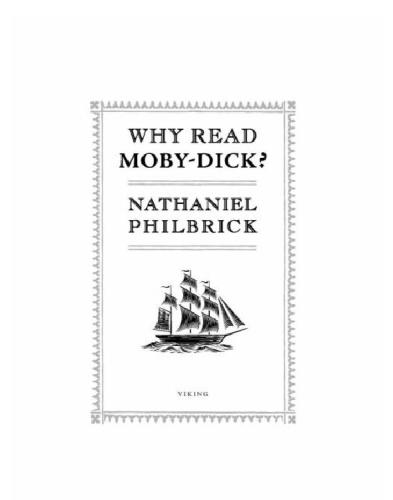
Why Read Moby-Dick?
کتاب های مرتبط
- اطلاعات
- نقد و بررسی
- دیدگاه کاربران
نقد و بررسی

August 15, 2011
Answering the negative of Philbrick’s titular question is easy: Moby-Dick is intimidatingly large, scientifically rigorous, esoteric, and to some, may seem outdated. While the size of The Whale cannot be debated, Philbrick’s entreaty is as approachable as it is persuasive. In this cogent and passionate polemic for Melville’s masterpiece, Philbrick (In the Heart of the Sea) combines a critical eye and a reader’s adoration to make a case for Moby-Dick. The plights of the Pequod, Ishmael and Ahab may seem irrelevant (or worse, quaint) compared to today’s troubles, but Philbrick opines that within the pages of this American classic lie timeless archetypes whose relevance stretches across human history. Upon the loom of Melville’s narrative run numerous threads of insight and argument dealing with subjects as diverse as multiculturalism, homoeroticism, and transcendental experiences of the natural world. Less lit-crit and more readers’ guide, this tome will remind fans why they loved the book in the first place, and whet the appetites of trepid potential readers.

winterneeser - A story that is written SO well that it makes you feel like your standing right there looking at this Amazing story happen!

July 15, 2011
A slim celebration of the elements of a literary masterpiece—and its moody, obsessive author.
In his 2000 book, In the Heart of the Sea, historian Philbrick (The Last Stand: Custer, Sitting Bull, and the Battle of Little Bighorn, 2010, etc.) detailed the wreck of the Essex, a whaling ship that would become the model for the Pequod in Herman Melville's 1851 classic, Moby-Dick. Having read the novel more than a dozen times, he's inspired to undertake a brief study of what he feels makes the book so enduring. (However, it took a while to earn classic status, as he points out; a flop when it was first published, the book didn't earn the esteem of critics until after World War I.) The diversity of the crew and Melville's respect for each character anticipates decades of debates about racial tolerance, writes the author, and its interest in matters of religious truth, demagoguery and free enterprise ensure that American readers today can find resonances with contemporary social and political issues. But Philbrick isn't simply hunting for proof of the novel's ongoing "relevance." He praises Melville's acute understanding of "the microclimates of intimate human relations," takes a close look at some of the novel's more powerfully poetic passages and honors the Melville himself, who was plagued with self-doubt while writing the book. Melville's letters to his friend Nathaniel Hawthorne—which Philbrick argues are essential to understanding Moby-Dick—reveal the novelist to be struggling with the composition of the novel as well as the spiritual concerns he addressed in it. Philbrick constructs the narrative in brief chapters, often no more than a couple of pages, and his literary analysis is sometimes thin. However, he doesn't want to dwell long on the book's contents, but rather motivate readers to discover the book for themselves.
On that front, mission accomplished: Philbrick is an enthusiastic salesman for a sometimes daunting novel.
(COPYRIGHT (2011) KIRKUS REVIEWS/NIELSEN BUSINESS MEDIA, INC. ALL RIGHTS RESERVED.)

May 15, 2011
So you liked Philbrick's In the Heart of the Sea, which re-created the wreck of the whaleship Essex, inspiration for Herman Melville's Moby-Dick? Then you'll love Philbrick's new book, which vivifies Melville's classic for modern readers. From a wonderful and knowing writer who's also founding director of the Egan Maritime Institute on Nantucket. I really want to read; with a four-city tour.
Copyright 2011 Library Journal, LLC Used with permission.

Starred review from September 15, 2011
What a book Melville has written! Hawthorne exclaimed upon first reading Moby Dick. More than 150 years later, Philbrick echoes Hawthorne's enthusiasm. Although he repudiates the various interpretations of Melville's White Whale as a symbol of this or that human nemesis, Philbrick sees in Melville's story of the whale a mythically capacious emblem of the nation that incubated itpulsing with poetic imagination, threatened by grim contradictions, and doomed to a devastating catastrophe. Readers thus come to recognize, for instance, how Melville's portrayal of the Pequod's pious but hard-hearted owners mirrors the bifurcation separating the nation's high-spirited idealism from its real-world addiction to the profits of slavery. And in its harrowing denouement, this prescient novel anticipates the carnage of Cold Harbor and Antietam. To be sure, Philbrick sees in the novel more than a symbol of America's tragically flawed history; he marvels, in fact, at how deeply Melville plumbs mysteries that defy time and geography. By probing the circumstances surrounding Melville's writing of the novel, Philbrick illuminates the intense creative process through which the brooding author melded the darkest elements from the art of Hawthorne and Shakespeare in the crucible of his own fervent agnosticism. Sure to swell the readership of Melville's masterpiece.(Reprinted with permission of Booklist, copyright 2011, American Library Association.)

























دیدگاه کاربران